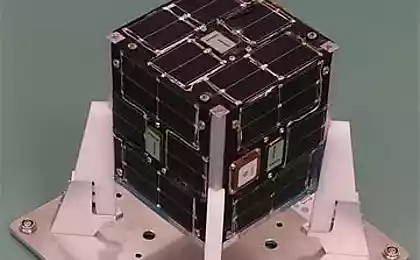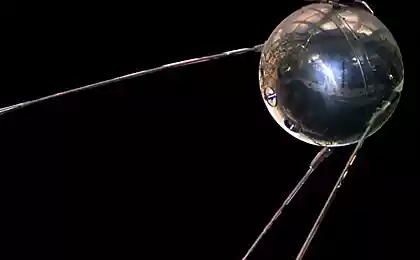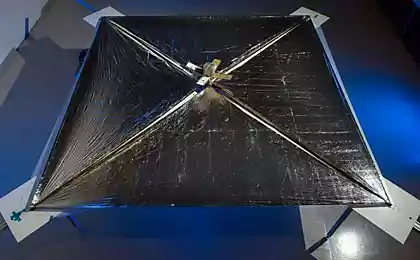1517
As born PolyITAN-1 in the laboratories of the CRPD

Development and manufacturing
The satellite was conceived a long time, although the development of a comprehensive plan as such was not, we can say there was a desire to start the development of the satellite without official support Space Agency of Ukraine, and the presence of the satellite at an early stage of development in our plans, National Technical University of Ukraine «КПИ ». Desire arose not out of the blue, in the department of nuclear engineering Thermophysics and Heat Energy at the Faculty KPI behind him a long history of close cooperation with the space industry. So, for cooling and thermal stabilization electronics artificial satellite "Sich" and "Ocean", space probes "Vega" and "Phobos", one of several German and Czech satellites use our heat pipes. But even by the faculty to pull the entire spectrum of work was impossible, because to look for specialists in other departments - were invited to develop employees with PEA, FEL, RTF, gather information and conduct consultations on various conferences, as it is, nevertheless, the first satellite. of the work that could be carried out under the pretext of specialized research faculty research have been done beforehand. Naturally most of the later had to redo, but experience in this matter would be superfluous.
For example the first version of the satellite body, steering centimeter Honeycomb, looked like.
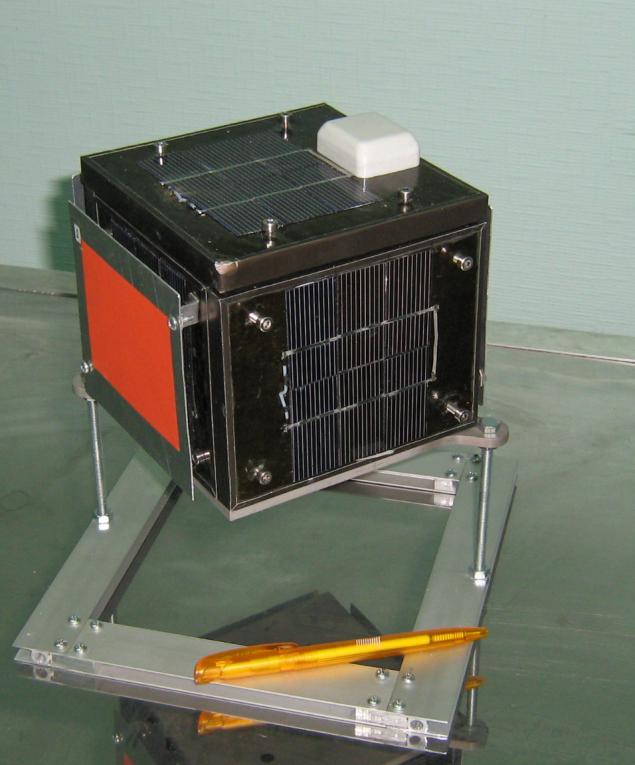
As the collection of information, it turned out that many problems can be avoided by bringing the satellite to the format CubeSat and paying place in the group with other startup satellites. Thickness honeycombs decreased almost threefold mechanism undock was not needed, and the satellite should be placed freely within the test design, which is called canister and kindly offered us a firm ISIS , Delft (The Netherlands).
Test canister (we prefer to call it a platform) QuadPack to check the size, the satellite should slide freely inside.

Work on the three-dimensional model of the satellite is not a problem in the drawing space is added only to the specifics of the obligatory indication of the design coordinate system fixed coordinate system and the orbital coordinate system, and indicates the orientation of the sensors in these systems of coordinates. Algorithms in the correct orientation need to convert the measurement results using the transition matrix from one coordinate system to another. Besides the three-dimensional model is the simplest way to calculate the center of mass and moments of inertia of the satellite with the disclosed antenna.
Fee onboard computer complex (IOO charge pictured with a GPS receiver mounted on the «Navis-Ukraine» ) developed at TEFe us on embedded systems specialist hired specifically to work with the satellite. During testing we have managed several times to burn a COM port on the GPS receiver.
The first version of the board of IOO.

Engaged on the development of the radio radio department KPI, were laid two radio channels: one operates in the UHF band to the amateur radio frequencies 437, 675 MHz (wavelength ~ 70 cm) and is used to transmit a beacon signal in CW (CW) and telemetry at 9600 bit / c, and the other - for data transmission in amateur band of 145 MHz.
Photos during mining software fees.
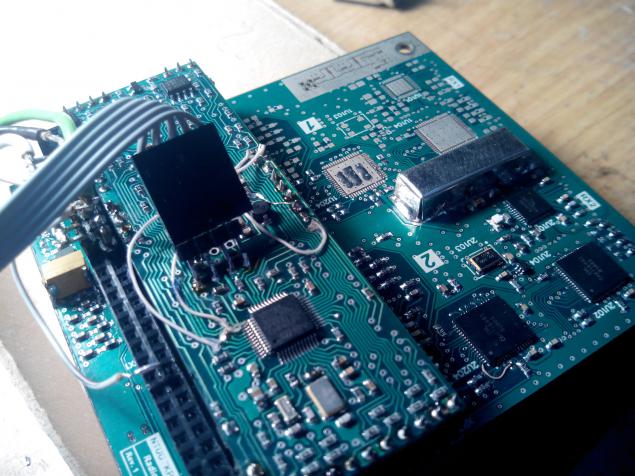
When she was working, working out especially pleased transmit / receive data with the card BVK. For two months in the laboratory was a "squeak" from the ground receiver. Listen to "tune" on the site of amateur radio UY2RA .
Students with RTF and TEFa is installing rooftop Fifth Corps RGB antenna equipment and cabling from the roof to the seventh floor, where we are the control center.
Our antenna farm.
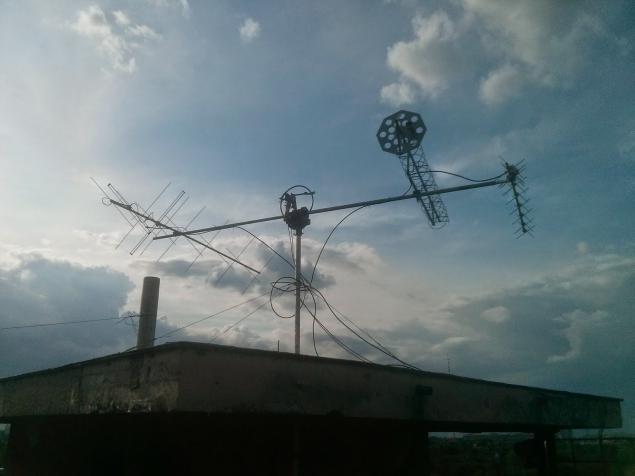
The board power supply subsystem with recesses for the wires. Develop a graduate student of the Faculty of Electronics KPI, he chooses LiFePO3 batteries and write to its board.

All dresses are made in «Kiev plant Radar» .
By bringing together the board, rather long practiced various algorithms and modes of the satellite. Average state workplace: power supply using polurazobrannom device simulating solar cells with a hit in the shadow of the Earth, the satellite feeds with batteries. Checks in which the battery is charged enough time, and in what not.
The photo immediately two satellites in different versions composure.

To control the orientation in such small satellites typically use magnetic coils which interact with the magnetic field of the Earth and the satellite is rotated. Interestingly, for their calculation used an old book over 35 years ago authorship Kovalenko AP "Magnetic control space vehicles» 1975 In step debugging instead of coils soldered resistors with twin diodes, which can be found in the photo above. < br />
If we talk about the complexity of the software IOO, it is easier to implement the task list:
- onboard real-time clock with clarification on GPS;
- the satellite regimes and their switching based on different data;
- module with Pattern Control;
- work with the receiver GPS / GLONASS protocol BINR;
- protocol MODBUS;
- Working with non-volatile flash memory for storage of telemetry;
- module collection and storage of telemetry in the archive;
- navigation algorithms (calculation and refinement of the orbit according to GPS);
- orientation and stabilization algorithm;
- Control Module coils; < Work with magnetic field sensors, angular velocity, the direction of the Sun;
- interaction with the boards of energy supply and the radio;
- a mechanism to convert the kernel into Sleep mode to reduce power consumption when there is no executable tasks ;
direction sensor on the sun. B> Development and manufacturing takes us in the CPI. If two words to describe the sensor device, then it is a small solar panel with four portions of the current pickup, covered with an opaque plate with two perpendicular cuts. The outputs from the photocells go to the chip to amplify the signal, which can then be measured on the ADC board BVK. After processing the captured data can be obtained vector pointing at the sun.
Photocell our sensor.
The sensor itself with the panel closed, the reverse side is a signal amplifier chip.
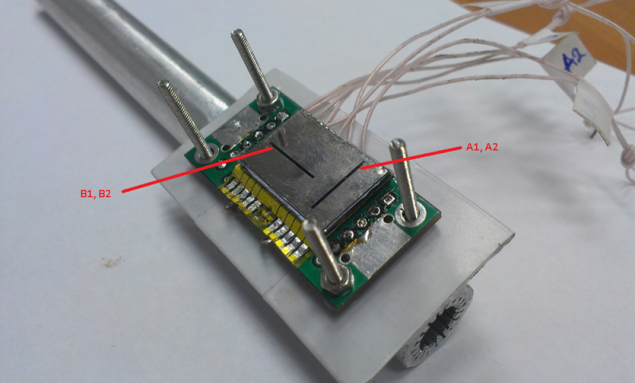
Ironically, the biggest problem was to test the sensor to find him a two-axle swivel stand with marking angles. For quality lighting answered our simulator trans-atmospheric solar radiation, the same as in the thermal vacuum test of our satellite. What will be slightly below the text.
Sought stand.

During calibration, do not forget that the planet Earth is also successfully reflects light and must be considered in error.

Sensors for continuous monitoring of the direction vector to the sun should be on each side of the satellite, but in our case they are fewer.
Tests
vibration testing. B> test equipment of Soviet era. The satellite has to withstand vibration and not fall apart. Information overload depends on the rocket and in this case were as follows: axial longitudinal overload - 7.5 g, transverse overload - 0.8 g, integrated speaker load - 140 dB.
Photo shaker unfortunately only mobile.

The thermo-vacuum tests. B> is conducted entirely in-house at our department one of the units www.lab-hp.kiev. ua . During tests simulated the conditions and the effect of space factors: low-temperature vacuum solar and terrestrial radiation black spaces that affect temperature control of electronic equipment and its reliability. Heat power department just specializes in such, because the test was carried out on its own with a detailed description of programs, procedures and production of scientific articles. PolyITAN-1 is protected from the cold of outer space by our Honeycomb, is a lightweight aluminum honeycomb (honeycomb height of 5 mm thick foil of 0, 023 mm), pasted on both sides of carbon-fiber skins with an insulating полиимидной film.
Honeycomb true with aluminum covers.
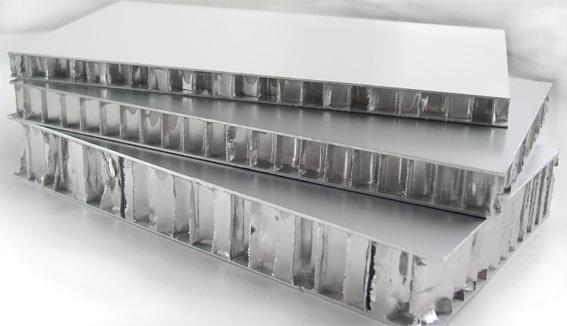
The simulator must provide solar radiation 1400 W per square meter, for large objects it can sometimes look like a panel solarium and placed in a vacuum chamber with the test object. In our case, the external simulator. The light source penetrates into the vacuum chamber through a small window and a window in the cryopanels - screen nitrogen temperature -193 ° C and the degree of blackness over 0.93.
White labels is just a thermocouple for temperature control.
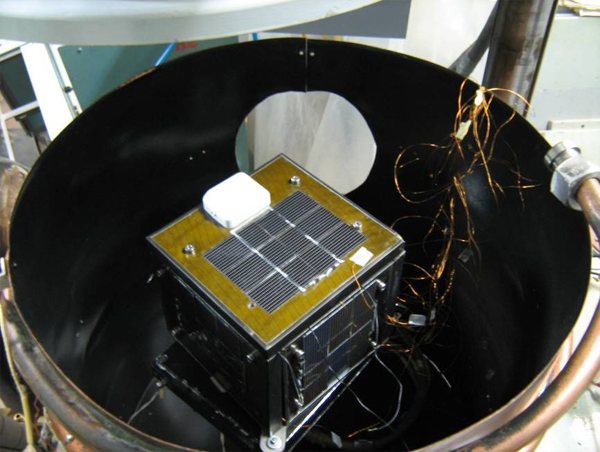
Open thermal vacuum chamber, nitrogen seen internal screen with thermocouples of slots porthole looks old version of the satellite.
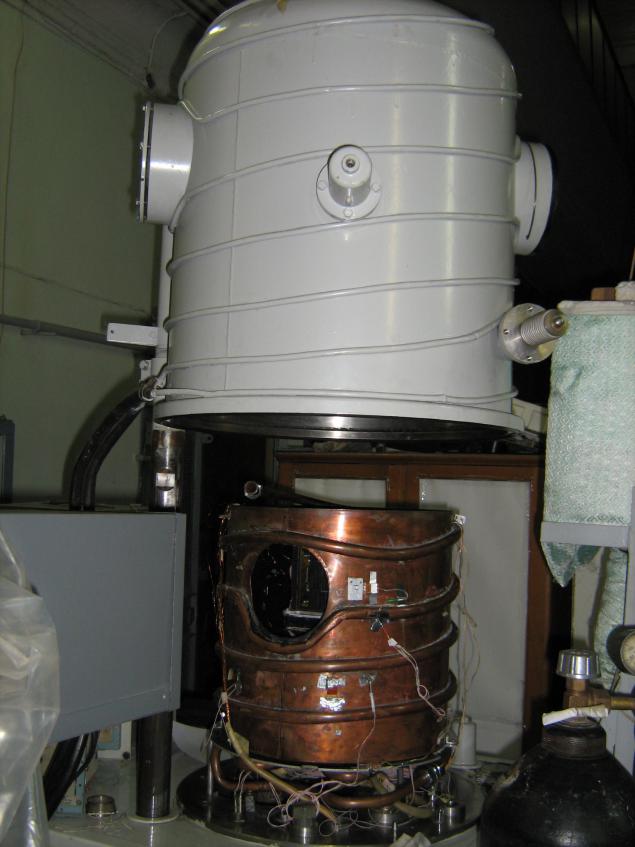
On a photo a general view of the equipment left - gun simulator solar radiation, and a vacuum chamber with porthole hard not to know.
Test results showed the temperature variation at the edges of solar batteries nanosatellite from -32 ° C in the shade to 65 ° C under the sun. Temperature conditions within the satellite was within tolerance for instrumentation. Battery to keep within the boundaries of +5 ... +9 ° C, warmed microcontroller from +5 to +23 ° C.
Effects of radiation. B> The tests were carried out on the M-30 microtron of the Institute of Electron Physics, National Academy of Sciences of Ukraine Uzhgorod. Experiencing the degree of degradation of electronic components and solar panels nanosatellite. From what I was told, this is the case, electrons are emitted from the microtron with an energy of 7 MeV and knock out the screen gamma radiation that falls on the already running boards and solar panels. Irradiation lasting about three hours (two approaches to the 5578 + 5578 c) simulates the effects of radiation for 18 months in near-Earth space. The boards fail to become the end of the first 1.5 hours of testing. The degree of degradation of the solar cell was only 3-5% and is calculated on the basis of current shoot before and after the test with the same luminous flux.
Photo microtron M-30 from the site IEF.

Sensor calibration. B> Absolutely all the sensors on the satellite must be calibrated. Some of them are the most important, as it is used in the orientation and stabilization. This magnetometers, an angular velocity sensor (DUSy), direction sensor on the sun. Others are more related to the state of the satellite, temperature sensors, and also implemented on this board sensors conditional disclosure antennas, battery charge current from the solar cell, the current consumption of various subsystems. About direction sensor on the Sun has been told above, the calibration of the remaining sensors needed for orientation, conducted outside the CRPD. In our satellite uses duplication, total twelve sensors and magnetometers grees. They are all electronic components on the board of IOO. Among the shortcomings, we can mention the extreme inaccuracy grees at low speeds, and magnetometers should ideally be outside, not inside the satellite, causing a distortion of the error is added to the design of the satellite.
Testing receiver GPS / GLONASS navigation and our algorithms. B> The company «Navis-Ukraine» a > in Smila provided us with the opportunity to test our navigation subsystems on their equipment. For us it was important to check the accuracy of the mathematical calculation and refinement of the orbit on real data from the reception of GPS / GLONASS signal on the antenna and to the use of the calculated data for the orientation of the satellite. Simulator GPS / GLONASS to simulate the signal coming from navigation satellites, as if we were flying on a given orbit us. Such a device is quite expensive and it should come bundled software that takes the values of consecutive points of the orbit or land route points in the data file for the simulator. For a specified interval of time (orbit or route) calculated the orbit of the selected navigation satellites, and then calculated for each satellite outgoing signals and the time of their arrival at the point of the orbit, including SRT. The obtained data for the simulation is recorded on a flash card that is already used in the simulator signals of GPS / GLONASS. Simulation output is connected instead of the receiver antenna and execute.
Simulator GPS / GLONASS.

Check popping your antenna. B> The only moving part in the whole design of the satellite is the mechanism responsible for the disclosure of antennas after launching into orbit. Satellite itself inside the launch container is in an off state. But after dropping into space freed contact battery, included satellite with some delay must disclose the antenna. This is an important and crucial stage in the life of the spacecraft.
Aerials of our satellite similar to the conventional roulette tape, constantly tending to turn around and straighten up. In the collapsed state of the antenna held limiters, when applying these current limiters burn and release the antenna.
In the photo with satellite antennas deployed.

Test popping your antennas.
The assembly and the road to the launch
Assembling in the basement laboratory with test all connected elements took more days. Fairly demanding job, doing that, you need to connect the assembly drawings on the board, wires combine all the elements of a satellite in a single system (motherboard, external sensors, batteries, solar cells, the mechanism of popping your antennas, magnetic control coils), connect the radio and GPS / GLONASS antenna correctly installed on the sensor panel direction to the sun, the panels bolted to the satellite. And at the end prepare the satellite for transportation.



Checkweighing show beautiful number.
In the road.

Generally satellite launch requires a strong interaction with the various government agencies and paperwork to obtain various permits. This is the most uninteresting and unpleasant part in its development, from which unfortunately can not be avoided. If the satellite is not created in the Ukrainian capital, then at least one person would have lived trips. Preparation of operating frequencies at national and international level as well as the paperwork for customs clearance may take longer. A lot of time-consuming procedure of the international registration from "UkrDTsradiochastot", "Ukrspetszv`yazku", "Ukrkosmos" and to ITU. In Ukraine, the procedure for University amateur satellites for the first time. In addition, the ITU needs to begin the registration process in the two years before the launch. Execution of documents for customs is also a major challenge associated with the need to prove the absence of state secrets. However, the availability of these documents are not exempt from scrutiny innards of our companion when crossing the border, one had to unscrew the panel.
Thus the satellite appeared before doing his duty border officials.
Opportune moment can be called repeatedly postponed the start. From the start on the scheduled date of December 2013 to launch June 19, 2014 Six months passed, which allowed us to qualitatively modify the satellite pair of subsystems, but something that we still barely have time. Question about skipping the start was quite acute.
The final adjustment in the Netherlands before loading platform .

Official and obligatory photo shoot for the satellite.
Runtastic Orbit: fitness tracker from producer fitness applications
Transformation backyard with his hands















